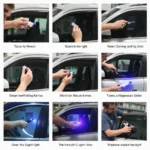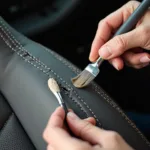Car seats endure a lot of wear and tear. From spills and crumbs to sun damage and general use, it’s no wonder they might need some TLC over time. Whether you’re dealing with a minor rip or a stubborn stain, this comprehensive guide will walk you through the process of repairing car seats and restoring their former glory.
Identifying the Damage: The First Step to Repair Car Seats
Before you jump into the repair process, it’s crucial to assess the type and extent of the damage to your car seats. This assessment will determine the appropriate repair methods and materials needed. Here are some common types of car seat damage:
- Rips, tears, and holes in fabric or leather: These can occur from sharp objects, rough use, or simply wear and tear over time.
- Burns: Cigarettes, lighters, and even hot objects can leave unsightly marks on your car seats.
- Stains: Food, drinks, ink, and other substances can cause stubborn stains that are difficult to remove.
- Fading and discoloration: Prolonged exposure to sunlight can fade the color of your car seats.
- Wear and tear on the seat bolsters and padding: This can occur from getting in and out of the car frequently, as well as from the weight of passengers.
DIY Car Seat Repair: Effective Solutions for Common Problems
For minor damage to your car seats, several DIY repair methods can effectively address the issue and save you a trip to the mechanic.
Repairing Minor Tears and Holes in Fabric Seats
- Using a Sewing Needle and Thread: This method works well for small tears and holes. Choose a thread that closely matches the color of your car seat fabric.
- Employing an Iron-On Patch: Iron-on patches offer a convenient solution for slightly larger tears. Make sure to choose a patch that is specifically designed for fabric upholstery.
- Applying Fabric Glue: Fabric glue can be used to bond the edges of a tear or hole together. Apply the glue sparingly and allow it to dry completely before using the seat.
Tackling Burns and Stains on Car Seats
- Removing Cigarette Burns: A mixture of baking soda and water can be used to gently scrub away the burn mark. For deeper burns, you may need to use a specialized leather or vinyl repair kit.
- Cleaning Up Spills and Stains: Blot the spill immediately with a clean cloth. Avoid rubbing, as this can spread the stain. For stubborn stains, a mixture of mild detergent and water or a specialized upholstery cleaner can be used.
how to repair car seats for cigarette burns
Addressing Fading and Discoloration
- Using a Fabric Protectant Spray: Regular application of a UV-protectant spray can help prevent fading and discoloration caused by sun damage.
- Dyeing Faded Fabric Seats: If your fabric seats have already faded, you can purchase a fabric dye that matches the original color to restore their appearance.
Restoring Worn-Out Seat Padding
- Adding Extra Padding: If the padding in your car seat has become compressed over time, you can add extra padding to improve comfort. Seat cushions or foam padding inserts are readily available.
“When addressing burns on leather seats, it’s crucial to assess the depth of the damage,” advises Johnathan Miller, an auto upholstery specialist at Miller’s Auto Trim. “For surface burns, a leather repair kit can work wonders, but deep burns may require professional intervention to restore the seat’s integrity.”
When to Seek Professional Car Seat Repair
While DIY methods can be effective for minor car seat repairs, certain situations warrant the expertise of a professional.
Signs You Need Professional Help
- Extensive Damage: If the damage to your car seats is extensive, such as large rips, tears, or burns, it’s best to consult a professional.
- Airbag Deployment: If your car has been in an accident and the airbags have deployed, it is critical to have the car seats inspected and repaired by a qualified technician.
- Seat Belt Issues: Any problems with your seat belts, such as fraying, tearing, or difficulty latching, require immediate attention from a professional.
Preventing Future Car Seat Damage: Proactive Care Tips
Preventing car seat damage is always easier than repairing it. Here are some proactive tips to keep your car seats looking their best:
- Use Seat Covers: Seat covers provide a protective barrier against spills, stains, and UV rays.
- Clean Your Seats Regularly: Vacuum your seats regularly to remove dirt and debris. Wipe down spills immediately with a clean cloth.
- Condition Leather Seats: Leather seats require regular conditioning to prevent drying and cracking.
“Investing in high-quality seat covers and incorporating regular cleaning into your car maintenance routine can significantly prolong the lifespan of your car seats and preserve their resale value,” says Sarah Thompson, a seasoned automotive detailer with over 15 years of experience.
Conclusion
Repairing car seats is an achievable task that can significantly improve the aesthetics and comfort of your vehicle’s interior. By following the guidelines outlined in this guide, you can confidently tackle common car seat issues and enjoy a more comfortable ride.
FAQs About Car Seat Repair
Can I dye leather car seats?
Yes, you can dye leather car seats to restore their color or change it entirely. However, it’s crucial to use a dye specifically designed for leather and to follow the manufacturer’s instructions carefully.
How much does it cost to reupholster car seats?
The cost of reupholstering car seats can vary depending on several factors, including the type of material used, the complexity of the job, and the labor rates in your area.
How can I prevent my car seats from cracking?
Regularly conditioning your leather seats with a high-quality leather conditioner can help prevent drying, cracking, and fading.
Can I repair a torn car seat seam myself?
Yes, you can repair a torn car seat seam using a needle and thread or a heavy-duty sewing machine. If you’re not comfortable sewing, you can always take your car seat to a professional upholsterer.
how to repair car seat trim panel cover
How do I remove pet hair from car seats?
A lint roller, a damp sponge, or a vacuum cleaner with a brush attachment can be used to remove pet hair from car seats.
What should I do if my car seat won’t adjust?
If your car seat won’t adjust, the problem could be with the seat adjuster mechanism. It’s best to consult a professional mechanic to diagnose and fix the issue.
For any further assistance or inquiries, feel free to reach out to our team of experts. Contact us via WhatsApp at +1(641)206-8880 or email us at [email protected]. We’re available 24/7 to address your car repair needs.



